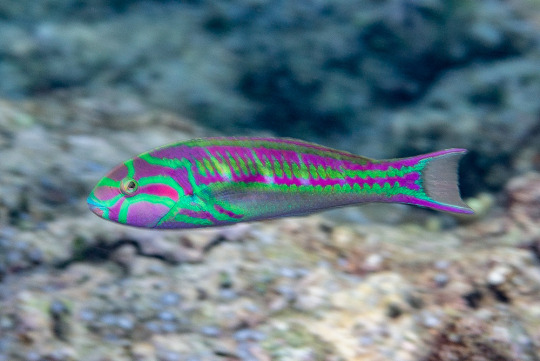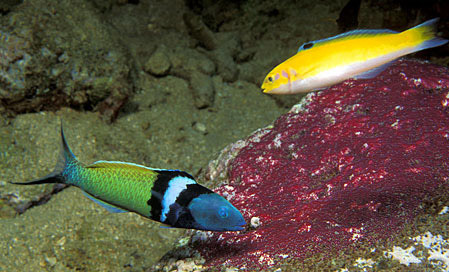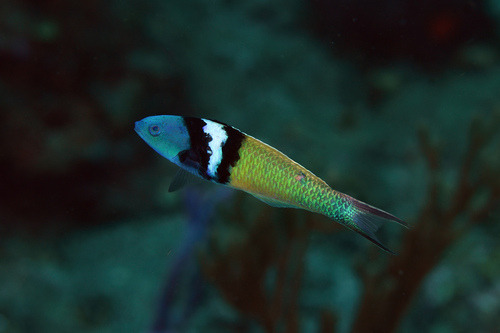#Thalassoma
Explore tagged Tumblr posts
Text

Surge Wrasse (Thalassoma purpureum), family Labridae, order Labriformes, Lord Howe Island, Australia
These fish are protogynous hermaphrodites. They all hatch out as females, and turn into males later in life.
photograph by Jordan Robins
336 notes
·
View notes
Text

#Thalassoma quinquevittatum#Thalassoma#Labridae#Labriformes#Actinopterygii#Chordata#fivestripe wrasse#wrasse#fish#wildlife#nature#animal#creative commons#indonesia
3 notes
·
View notes
Note
may i please have a colorful little guy :3
Just look at this little dood

You get a Bluehead Wrasse
Thalassoma bifasciatum
74 notes
·
View notes
Text



Once in a Blue Moon: The Bluehead Wrasse
The bluehead wrasse (Thalassoma bifasciatum) is a small species of wrasse found only in the western Atlantic Ocean; particularly around the Caribbean and the northern coast of South America. They inhabit coral reefs, and occasionally along sandy bottoms and sea grass meadows. Bluehead wrasse prefer shallow, warm, clear water and reefs with lots of hiding places that they can easily access.
T. bifasciatum is noted for its bright coloration. Females and small males are bright yellow with a white underbelly, while larger males have a greenish body and a blue head, seperated by thick black and white stripes. These large males are typically 7-8 cm (2.7-3.1 in) in length, while smaller males and females are around 6 cm (2.3 in).
Like many coral reef fish species, the bluehead wrasse engages in protogyny. All eggs hatch as females, and as they mature some change into males. These young males, known as initial phase (IP) males, continue to resemble females but are fully capable of reproduction. Eventually, the largest of them transition into a secondary phase, also known as the terminal phase (TP). TP males carry the characteristic blue and green markings of bluehead wrasse, and are significantly larger. The transition from female to IP, IP to TP, or even directly from female to TP can occur at any time, and is particularly triggered by removal of dominant (TP) males from a population.
Reproduction typically occurs from January to August, though it can continue sporadically throughout the year. Mature adults participate in group spawns, in which females and both male types converge at spawning sites. Males compete for proximity to females, and typically TP males will closely guard access to a harem of 30-50 females, while IP males will attempt to use their coloring to sneak in and mate surreptitiously. T. bifasciatum are broadcast spawners; both sexes release their gametes into the water column, where they are fertilized and carried away by the current.
Eggs spend 6-8 months free floating, sometimes drifting miles from their spawning grounds. After hatching into juveniles (larvae), they burrow into the sand and remain there for several months before emerging to seek out a coral reef in which to shelter. At this point, a year after hatching, they are typically mature and ready to mate themselves. Individuals can live up to 3 years in the wild, though juvenile mortality is high.
Bluehead wrasse are cleaner fish. The majority of their food are parasites picked off of larger fish, as well as shrimp, krill, crustaceans, and plankton gathered from the coral itself. However, they are also often food themselves for larger fish, moray eels, and stingrays.
Conservation status: The IUCN considers the bluehead wrasse to be Least Concern. Their primary threat is habitat loss due to coral reef bleaching.
If you like what I do, consider buying me a ko-fi!
Photos
Doug Perrine
Terence Zahner
Nick Hobgood
#bluehead wrasse#Labriformes#Labridae#wrasses#ray-finned fish#bony fish#fish#marine fauna#marine fish#coral reefs#coral reef fish#atlantic ocean#queer animals#queer fauna
44 notes
·
View notes
Text
day 206, 17/01/25 - fish of the day is the moon wrasse (Thalassoma lunare)

17 notes
·
View notes
Text
First Fish Yap Post - Labridae!
I figure it fit for the first post in this blog to be about my favourite fish family ever - Labridae - the wrasses, parrotfishes and cales.
Introduction Labridae is a diverse (and extremely cool!) family of fishes, encompassing nearly 700 species, and occur in tropical and temperate marine waters worldwide - none inhabit freshwater. Typically, they are elongate, small to medium in size and colourful, and the greatest species diversity is found on tropical coral reefs.

This green fellow is Thalassoma lunare - the Moon Wrasse. By all means, a fairly 'typical' wrasse.
Taxonomy The number of species included within Labridae has increased over time, not only by the description of new species, but also from species from other families being reclassified as members of Labridae - notably, the parrotfishes (formerly family Scaridae) and the cales (formerly family Odacidae). The parrotfishes and cales were always considered to be close relatives of Labridae, but genetic studies have shown that these groups are deeply nested within Labridae, and thus should be classified in this family. The closest living relatives of Labridae, based on genetic evidence, appears to be the curious family Centrogenyidae, the false scorpionfishes.

This is Scarus rivulatus - the Surf Parrotfish. Formerly placed in the family Scaridae, but along with all other parrotfishes, is now included in Labridae

Siphonognathus caninis - the Sharp-nosed Weed-whiting. Formerly placed in Odacidae (a family of temperate marine fishes found only in southern Australia and New Zealand), but along with all other Odacidae species is now included in Labridae.
Diets and Feeding This is where the labrids really get interesting. The vast majority of labrids are carnivorous - typically subsisting on crustaceans, molluscs and other invertebrate prey. The 'typical' carnivorous wrasses possess simple, peglike teeth to break down their (often shelled) prey, but many groups show interesting specialisations to the mouth, jaws and teeth to exploit other food sources.
The aforementioned parrotfishes and cales are largely herbivorous, and have specialised tooth structures to facilitate this diet - in parrotfishes, their teeth have fused into a thick, parrot-like beak to scrape algae from rocks. In doing this, the top layer of rock is also scraped off and ingested, to be later excreted as the fine white sand on tropical beaches that humans find so appealing. So next time you find yourself on a gorgeous tropical beach, don't forget that you're standing on a giant accumulated mound of parrotfish poo! The cales take a similar but different approach to herbivory - they too have fused beaklike teeth, but use them like a pair of garden shears to clip mouthfuls of algae and seaweed.
Some wrasses are plankivorous, aggregating in shoals that hover at the edge of the reef to pick at plankton floating by on the currents - this guild includes the likes of the genus Cirrhilabrus and smaller species of Thalassoma.
The Slingjaw Wrasse (Epibulus insidiator) has a most unusual mouth structure that allows it to massively extend it's jaws, forming a frankly absurd tubelike structure to allow it to slurp up small fish and shrimp that may be hiding in small crevices. The ability to protrude the mouth out like this is common amongst ray-finned fishes, but few can do so to the ridiculous extent of the Slingjaw Wrasse. I HIGHLY recommend looking up a video of the slingjaw in action, it's super cool.

Epibulus indidiator (Slingjaw Wrasse) showing off it's frankly absurd jaw protrusion. When the jaws are retracted, they sit flat against the rest of the head.
The various species of tubelip wrasses are specialists on a very strange diet - the mucus secreted by corals. As the name suggests, these fishes have unusually long and fleshy lips that come together to form a sealed tube, with which the fish uses to create a tight seal against a piece of coral and sucks up the mucus.

Labrichthys unilineatus, one such species of tubelip wrasse. Look at those lips!
Perhaps the best-known feeding specialisation in wrasses is that of species that clean other fishes of parasites, food waste and dead skin. Many wrasse species engage in cleaning behaviour as juveniles, but a few (such as the genus Labroides, the well-known 'cleaner wrasses') continue this behaviour into adulthood, and make it their primary source of sustenance. These small, striped wrasses will set up 'cleaning stations' on the reef, attended by one or more cleaner wrasses - typically, a reef with have several of these stations. Most sedentary fish species will simply visit the cleaning station closest to their territory, but wider-ranging species are willing to travel considerable distance to visit the stations that offer the best service, so competition between cleaning stations is fierce to provide the best services to win these picky customers. The cleaner wrasses will give preferential treatment to non-local fish to win their favour, and can individually recognise hundreds of fishy customers from different species. Even large, predatory fish species are accepted customers, and the cleaner wrasses will happily enter the mouths and gills of groupers, sharks and eels to clean them. Only on very rare occasions will such a predator eat a cleaner wrasse - the benefit of the wrasse's cleaning services is greater to the predator than the immediate caloric benefit of consuming the wrasse, so the wrasse can swim straight into the mouth of predatory fish with impunity.

Labroides dimidiatus (Bluestreak Cleaner Wrasse), the best-known species of the genus Labroides.
Sex-swapping and Reproductive Strategies An extremely interesting (but not entirely unique) trait of the wrasses is their ability to change sex, and the reproductive systems this enables. Almost all wrasses are born females, and can become male later in life. Often, juvenile female wrasses will join harems, consisting of numerous juveniles and adult females, and a single male. In these harems, there is a strict dominance hierarchy, with each fish harassing those lower in the ranks than itself. This constant low-level stress inhibits the hormone production that would cause a female wrasse to transition into a male - except for the most dominant fish, which is free to transform into a male. Usually, the dominant male will bear different colouration and patterning to the other fish in the harem, making the boss easy to pick out from the rest. The dominant male in a wrasse harem will frequently spawn with the adult females. However, if the dominant fish is removed from the harem (eg. if he dies, or is kicked out after losing a dominance contest to another wrasse), the most dominant female will become male to take his place. The behavioural change is almost instantaneous - the new dominant fish will become more aggressive - but the change in colouration and gonads can take a few weeks to a few months.

Female Thalassoma amblycephalum (Blunthead Wrasse)

Dominant male of the same species. It's easy to see how often, male and female of the same wrasse species can be incorrectly identified as being different species - even by scientists!
Intelligence and Tool Use Perhaps, 'intelligent' is not a word often used to describe fishes, but wrasses would certainly be among the brainiest of the fishes. The previously mentioned Bluestreak Cleaner Wrasse is one of the few fish to have demonstrated self-awareness via the mirror test (although the mirror test has rarely been attempted on fishes, so perhaps the number of self-aware fish out there is higher than we realise), and several wrasse species (particularly the tuskfishes of the genus Choerodon) have been observed to use tools. Tuskfishes have a pretty fearsome set of teeth that they use to break through the shells of their prey, but that alone is not enough to break the thickest of clam shells - so they use tools to smash the clams. A tuskfish, upon finding a clam too solid to bite through, will carry it in it's mouth to a habitually used rock or knob of coral, and with the clam still in it's mouth, flick it's head to hit the clam against the rock to break it. Only rarely does this work the first try, but the tuskfish is persistent, and will repeatedly hit the clam until it breaks, allowing the fish entry to consume the flesh inside.

Choerodon anchorago (Anchor Tuskfish), one species that has been observed to use tools to break open clam shells.
Sleep Labrids have some pretty interesting behaviours to avoid being eaten while they sleep (although it could be argued fish do not truly 'sleep', saying 'sleep-like resting state' every time is too wordy so I'll just say 'sleep'). Many species will burrow into the sand to sleep, to hide from predators - a behaviour that can be alarming to the beginner saltwater aquarist, who may be terrified to find that their newly-acquired wrasse has suddenly dissappeared when the tank lights are turned off! Other species (especially the parrotfishes) produce a bubble of mucus to sleep in, like a sleeping bag made of snot. They make a new bubble every night, the purpose of which is to conceal the fish's scent from predators as it sleeps in a crevice or under a head of coral, as well as to prevent parasites settling on the fish's skin. In the morning, the fish will eat it's way out of it's mucus bubble.

A parrotfish (I'm not sure which species exactly) sleeping in it's mucus bubble.
Oh, and did I mention that some wrasses are drop-dead GORGEOUS???? Just LOOK at these

Cirrhilabrus hygroxerus - Monsoon Fairy Wrasse

Cirrhilabrus cyanopleura - Blueside Fairy Wrasse. This colour form of the species with the yellow spot on the flanks was previously considered a seperate species (Cirrhilabrus ryukyuensis), but has been reclassified as a colour variant of C. cyanopleura.

Macropharyngodon meleagris - Leopard Wrasse

Gomphosus varius - Pacific Bird Wrasse. Boy, why you so nose??

Cheilinus undulatus - Humphead Maori Wrasse. This is the largest species in the family Labridae (reaching a whopping 2.3 metres!), and unfortunately also one of the most threatened - it is heavily fished for the seafood trade, and it's slow growth makes it easily overharvested.

Lachnolaimus maximus - Hogfish
16 notes
·
View notes
Text
🐠 - Fishuary!!

day 3 - wrasse
blue headed wrasse / thalassoma bifasciatum
@fish-daily
#fishuary 2024#fishuary#drawing challenge#drawing challenge 2024#wrasse#fish drawing#fish art#fishblr#colored pencil art#small artist#artists of tumblr#traditional art#traditional artists#traditional drawing#colored pencil
36 notes
·
View notes
Text

You get a Fivestripe Wrasse
Thalassoma quinquevittatum
7 people walk into a train car, 3 stops later 10 people walk out
1K notes
·
View notes
Text

Moon Wrasse (Thalassoma lunare), family Labridae, Great Barrier Reef, Cairns, Australia
Like many wrasses, this species is a protogynous sequential hermaphrodite. They start off their lives as females, and become males when they get older.
photograph by Leonard Low
#wrasse#thalassoma#labridae#fish#ichthyology#animals#nature#australia#ocean#pacific ocean#indian ocean
151 notes
·
View notes
Photo


I’ve been having a lot of headaches due to all the time I have been spending on the screen during the pandemic. This has made it hard to do digital art.
Instead have a traditional drawing of a male ornate (or peacock) wrasse, Thalassoma pavo.
This was my favorite fish to encounter while snorkeling in Lebanon. In Arabic it is known as the “bridefish,” but its reproductive strategy is more unusual than that name suggests. A single male lives in a group with a harem of females, but all of the wrasse are born female. When the lead male dies, the dominant female transforms into a male to lead the shoal. This makes them sequential hermaphrodites.
They are typically found over rocks that are covered in coralline algae and red, brown, and green seaweed, so their bright magenta, turquoise, and spring green colors don’t stand out as obviously as one might expect. They swim by flapping their pectoral fins, flitting about the rocks like butterflies. They sleep at night buried in the sand.
The female is similar in color to the male, but has brown patches and black spots in place of the male’s red-edged body scales.
#colored pencil#oil pastel#ornate wrasse#wrasse#fish#marine biology#mediterranean sea#thalassoma#science#my oil pastels are so old and dry
20 notes
·
View notes
Note
POISSON D'AVRIL !!! Feligami except they're a girelle-paon (thalassoma pavo) and leafy sea dragon 💖💖💖💖💖💖


Poisson d’Avril! ❤️🐠
SWEETHEART I LOVE YOU I LOVE YOU I LOVE YOU 💖💖💖💖💖💖💖💖💖💖💖💖💖💖💖💖💖💖💖💖💖💖💖💖💖💖💖💖💖💖💖💖💖💖💖💖
13 notes
·
View notes
Photo

Moon wrasse - Thalassoma lunare
299 notes
·
View notes
Note
MAY I get a fish please!!! i love weird lookin thangs
Fish that was colored in by a first grader (affectionate)

You get a Sixbar Wrasse
Thalassoma hardwicke
74 notes
·
View notes
Photo

Sunset wrasse (Thalassoma lutescens) terminal phase male off the coast of Tahiti in French Polynesia
François Libert
73 notes
·
View notes
Text
day 61, 24/03/24 - fish of the day is the bluehead wrasse (Thalassoma bifasciatum)

10 notes
·
View notes